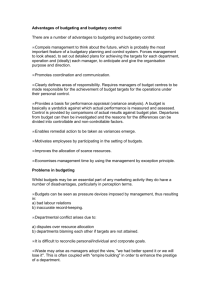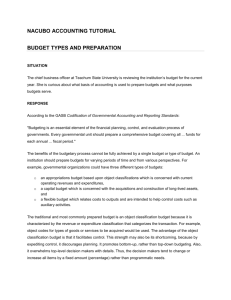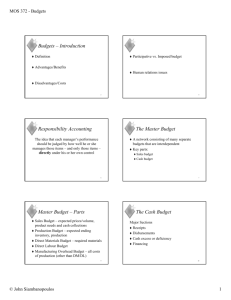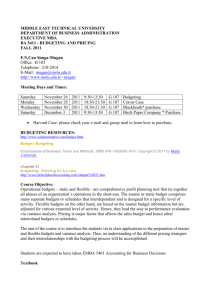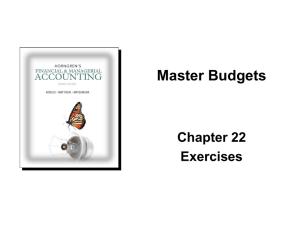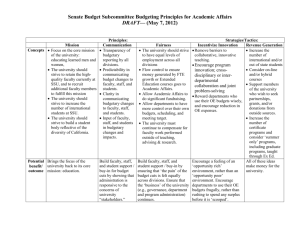budgeting and budgetary control
advertisement
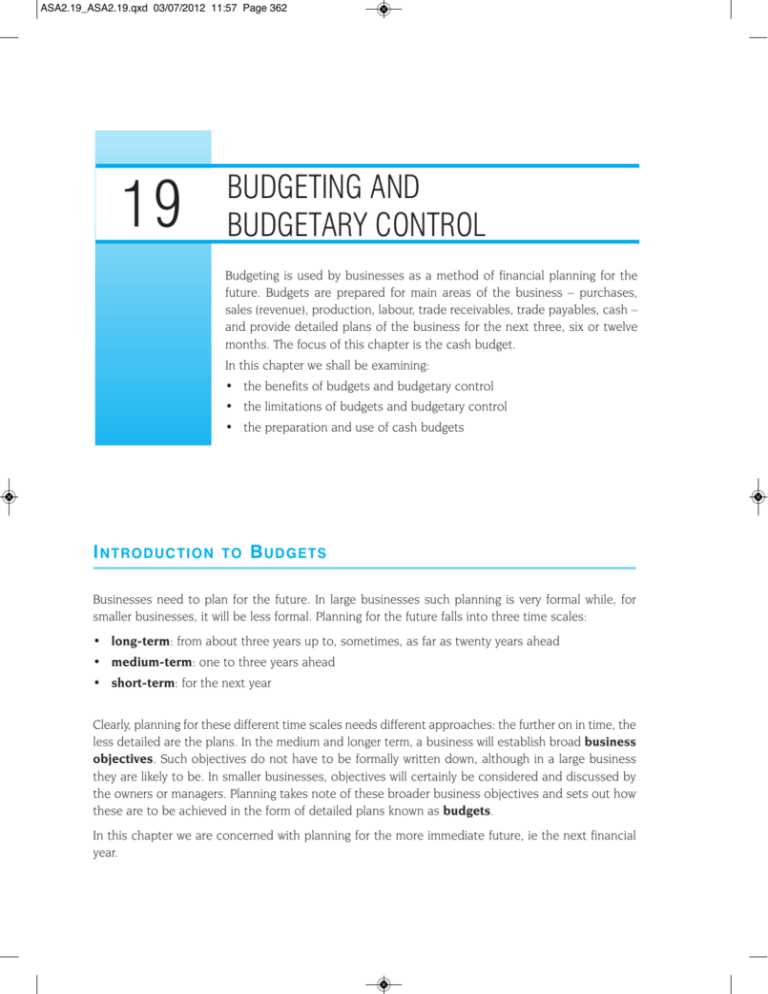
ASA2.19_ASA2.19.qxd 03/07/2012 11:57 Page 362 19 BUDGETING AND BUDGETARY CONTROL Budgeting is used by businesses as a method of financial planning for the future. Budgets are prepared for main areas of the business – purchases, sales (revenue), production, labour, trade receivables, trade payables, cash – and provide detailed plans of the business for the next three, six or twelve months. The focus of this chapter is the cash budget. In this chapter we shall be examining: • the benefits of budgets and budgetary control • the limitations of budgets and budgetary control • the preparation and use of cash budgets I NTRODUCTION TO B UDGETS Businesses need to plan for the future. In large businesses such planning is very formal while, for smaller businesses, it will be less formal. Planning for the future falls into three time scales: • long-term: from about three years up to, sometimes, as far as twenty years ahead • medium-term: one to three years ahead • short-term: for the next year Clearly, planning for these different time scales needs different approaches: the further on in time, the less detailed are the plans. In the medium and longer term, a business will establish broad business objectives. Such objectives do not have to be formally written down, although in a large business they are likely to be. In smaller businesses, objectives will certainly be considered and discussed by the owners or managers. Planning takes note of these broader business objectives and sets out how these are to be achieved in the form of detailed plans known as budgets. In this chapter we are concerned with planning for the more immediate future, ie the next financial year. ASA2.19_ASA2.19.qxd 03/07/2012 11:57 Page 363 budgeting and budgetary control 363 W HAT IS A B UDGET ? A budget is a financial plan for a business, prepared in advance. A budget may be set in money terms, eg a sales budget of £500,000, or it can be expressed in terms of units, eg a purchases budget of 5,000 units to be bought. Budgets can be income budgets for money received, eg a sales budget, or expenditure budgets for money spent, eg a purchases budget. The budget we shall be focusing on in this chapter is the cash budget, which combines both income and expenditure, estimating what will happen to the bank balance during the time period of the budget. Most budgets are prepared for the next financial year (the budget period), and are usually broken down into shorter time periods, commonly four-weekly or monthly. This enables budgetary control to be exercised over the budget: the actual results can be monitored against the budget, and discrepancies between the two can be investigated and corrective action taken where appropriate. B ENEFITS OF B UDGETS AND B UDGETARY C ONTROL Budgets provide benefits both for the business, and also for its managers and other staff: the budget assists planning By formalising objectives through a budget, a business can ensure that its plans are achievable. It will be able to decide what is needed to produce the output of goods and services, and to make sure that everything will be available at the right time. the budget communicates and co-ordinates Because a budget is agreed by the business, all the relevant managers and staff will be working towards the same end. When the budget is being set, any anticipated problems should be resolved and any areas of potential confusion clarified. All departments should be in a position to play their part in achieving the overall goals. the budget helps with decision-making By planning ahead through budgets, a business can make decisions on how much output – in the form of goods or services – can be achieved. At the same time, the cost of the output can be planned and changes can be made where appropriate. ASA2.19_ASA2.19.qxd 03/07/2012 11:57 Page 364 364 AS Accounting for AQA the budget can be used to monitor and control An important reason for producing a budget is that management is able to use budgetary control to monitor and compare the actual results (see diagram below). This is so that action can be taken to modify the operation of the business as time passes, or possibly to change the budget if it becomes unachievable. BUDGET FIGURES CONTROL AND TAKE ACTION ACTUAL FIGURES MONITOR AND COMPARE the budget can be used to motivate A budget can be part of the techniques for motivating managers and other staff to achieve the objectives of the business. The extent to which this happens will depend on how the budget is agreed and set, and whether it is thought to be fair and achievable. The budget may also be linked to rewards (for example, bonuses) where targets are met or exceeded. L IMITATIONS OF B UDGETS AND B UDGETARY C ONTROL Whilst most businesses will benefit from the use of budgets, there are a number of limitations of budgets to be aware of: the benefit of the budget must exceed the cost Budgeting is a fairly complex process and some businesses – particularly small ones – may find that the task is too much of a burden in terms of time and other resources, with only limited benefits. Nevertheless, many lenders – such as banks – often require the production of budgets as part of the business plan. As a general rule, the benefit of producing the budget must exceed its cost. budget information may not be accurate It is essential that the information going into budgets should be as accurate as possible. Anybody can produce a budget, but the more inaccurate it is, the less use it is to the business as a planning and control mechanism. Great care needs to be taken with estimates of sales – often the starting point of the budgeting process – and costs. Budgetary control is used to compare the budget against what actually happened – the budget may need to be changed if it becomes unachievable. ASA2.19_ASA2.19.qxd 03/07/2012 11:57 Page 365 budgeting and budgetary control 365 the budget may demotivate Employees who have had no part in agreeing and setting a budget which is imposed upon them, will feel that they do not own it. As a consequence, the staff may be demotivated. Another limitation is that employees may see budgets as either a ‘carrot’ or a ‘stick’, ie as a form of encouragement to achieve the targets set, or as a form of punishment if targets are missed. budgets may lead to disfunctional management A limitation that can occur is that employees in one department of the business may over-achieve against their budget and create problems elsewhere. For example, a production department might achieve extra output that the sales department finds difficult to sell. To avoid such disfunctional management, budgets need to be set at realistic levels and linked and co-ordinated across all departments within the business. budgets may be set at too low a level Where the budget is too easy to achieve it will be of no benefit to the business and may, in fact, lead to lower levels of output and higher costs than before the budget was established. Budgets should be set at realistic levels, which make the best use of the resources available. W HAT B UDGETS ARE P REPARED ? Budgets are planned for specific sections of the business: these budgets can then be controlled by a budget holder, who may be the manager or supervisor of the specific section. Such budgets include: • purchases budget – what the business needs to buy to make/supply the goods it expects to sell • sales (revenue) budget – what the business expects to sell • production budget – how the business will make/supply the goods it expects to sell • labour budget – the cost of employing the people who will make/supply the goods • trade receivable budget – how much the business will receive from credit sales • trade payable budget – how much the business will pay for credit purchases • cash budget – how much money will be flowing in and out of the bank account The end result of the budgeting process is often the production of a master budget, which takes the form of forecast operating statements – forecast income statement – and forecast balance sheet. The master budget is the ‘master plan’ which shows how all the other budgets ‘work together’. Note that, in this chapter, we focus our attention on the cash budget; you will examine the other budgets, including the master budget, if you go on to study A2 Accounting. ASA2.19_ASA2.19.qxd 03/07/2012 11:57 Page 366 366 AS Accounting for AQA B UDGETARY P LANNING Many large businesses take a highly formal view of planning the budget and make use of: • a budget manual, which provides a set of guidelines as to who is involved with the budgetary planning and control process, and how the process is to be conducted • a budget committee, which organises the process of budgetary planning and control; this committee brings together representatives from the main functions of the business – eg production, sales, administration – and is headed by a budget co-ordinator whose job is to administer and oversee the activities of the committee In smaller businesses, the process of planning the budget may be rather more informal, with the owner or manager overseeing and budgeting for all the business functions. Whatever the size of the business it is important, though, that the planning process begins well before the start of the budget period; this then gives time for budgets to be prepared, reviewed, redrafted, and reviewed again before being finally agreed and submitted to the directors or owners for approval. For example, the planning process for a budget which is to start on 1 January might commence in the previous June, as follows: • June Budget committee meets to plan next year’s budgets • July First draft of budgets prepared • August Review of draft budgets • September Draft budgets amended in light of review • October Further review and redrafting to final version • November Budgets submitted to directors or owners for approval • December Budgets for next year circulated to managers • January Budget period commences C ASH B UDGET A cash budget sets out the expected cash/bank receipts and payments, usually on a monthby-month basis, for the next three, six or twelve months, in order to show the estimated bank balance at the end of each month throughout the period. From the cash budget, the managers of a business can decide what action to take when a surplus of cash is shown to be available or, as is more likely, when a bank overdraft needs to be arranged. layout of a cash budget A suitable format for a cash budget, with sample figures, is set out on the next page. ASA2.19_ASA2.19.qxd 03/07/2012 11:57 Page 367 budgeting and budgetary control 367 Name ................................................Cash Budget for the .................. months ending .............................. Jan Feb Mar Apr £000 £000 £000 £000 from trade receivables 150 150 161 170 Total receipts for month (A) 220 230 236 250 eg 160 165 170 170 220 230 16 20 1 21 Receipts eg cash sales Payments to trade payables expenses non-current assets Total payments for month (B) Net cash flow (Receipts less Payments, ie A–B) Add bank balance at beginning of month Bank balance (overdraft) at end of month 70 50 80 50 50 210 265 10 (35) 20 (15) 10 20 75 50 (15) 80 60 1 sections of a cash budget A cash budget consists of three main sections: • receipts for the month • payments for the month • summary of bank account Receipts are analysed to show the amount of money that is expected to be received from cash sales, trade receivables, sale of non-current assets, capital introduced/issue of shares, loans received etc. Payments show how much money is expected to be paid in respect of cash purchases, trade payables, expenses (often described in cash budgets as operating expenses), purchases of noncurrent assets, repayment of capital/shares and loans. Note that non-cash expenses (such as depreciation and doubtful debts) are not shown in the cash budget. The summary of the bank account at the bottom of the cash budget shows net cash flow (total receipts less total payments) added to the bank balance at the beginning of the month, and resulting in the estimated closing bank balance at the end of the month. An overdrawn bank balance is shown in brackets. The main difficulty in the preparation of cash budgets lies in the timing of receipts and payments – for example, trade receivables may pay two months after date of sale, or trade payables may be paid by the business one month after date of purchase: it is important to ensure that such receipts and payments are recorded in the correct month column. ASA2.19_ASA2.19.qxd 03/07/2012 11:57 Page 368 368 AS Accounting for AQA Remember that the cash budget, as its name suggests, deals only in cash/bank transactions; thus non-cash items, such as depreciation, are never shown. Where cash discounts are allowed or received, only the actual amount of money expected to be received or paid is recorded. Similarly, where a business incurs bad debts, only the amount of money expected to be received from good trade receivables is recorded in the cash budget. WORKED EXAMPLE : CASH BUDGET situation A friend of yours, Mike Anderson, has recently been made redundant from his job as a sales representative for an arts and crafts company. Mike has decided to set up in business on his own selling art supplies to shops and art societies. He plans to invest £20,000 of his savings into the new business. He has a number of good business contacts, and is confident that his firm will do well. He thinks that some additional finance will be required in the short term and plans to approach his bank for this. Mike asks for your assistance in producing a cash budget for his new business for the next six months. He provides the following information: • The business, which is to be called ‘Art Supplies’ will commence in January 20-8. • Non-current assets costing £8,000 will be bought in early January. These will be paid for immediately and are expected to have a five-year life, at the end of which they will be worthless. • An initial stock (inventory) of goods costing £5,000 will be bought and paid for at the beginning of January. • Monthly purchases of goods will then be made at a level sufficient to replace forecast sales for that month, ie the goods he expects to sell in January will be replaced by purchases made in January, and so on. • Forecast monthly sales are: January £3,000 February £6,000 March £6,000 April £10,500 May £10,500 June £10,500 • The selling price of goods is fixed at the cost price plus 50 per cent; for example, the goods he expects to sell in January for £3,000 will have cost him £2,000 (two-thirds of the selling price), ie his mark-up is 50%. • To encourage sales, he will allow two months’ credit to customers; however, only one month’s credit will be received from suppliers of goods (but the initial goods will be paid for immediately). • Operating expenses of the business, including rent of premises, but excluding depreciation of non-current assets, are estimated at £1,600 per month and are paid for in the month in which they are incurred. • Mike intends to draw £1,000 each month in cash from the business. You are asked to prepare a cash budget for the first six months of the business. ASA2.19_ASA2.19.qxd 03/07/2012 11:57 Page 369 budgeting and budgetary control 369 solution Mike Anderson, trading as ‘Art Supplies’ Cash budget for the six months ending 30 June 20-8 Jan Receipts £ Capital introduced 20,000 Total receipts for month 20,000 Trade receivables Payments Non-current assets Inventory Trade payables Operating expenses Drawings – Feb Mar Apr May Jun – 3,000 6,000 6,000 10,500 £ £ £ £ £ – 3,000 6,000 6,000 10,500 2,000 4,000 4,000 7,000 7,000 8,000 5,000 – 1,600 1,000 1,600 1,000 1,600 1,000 1,600 1,000 1,600 1,000 Total payments for month 15,600 4,600 6,600 9,600 9,600 Add bank balance (overdraft) at beginning of month – 4,400 (200) (3,800) (4,400) (8,000) Net cash flow Bank balance (overdraft) at end of month 4,400 (4,600) (3,600) 4,400 6,600 1,600 1,000 (600) (3,600) (200) (3,800) (4,400) (8,000) 900 (7,100) Reminder: No depreciation – a non-cash expense – is shown in the cash budget. Notes: • purchases are two-thirds of the sales values (because selling price is cost price plus 50 per cent) • customers pay two months after sale, ie trade receivables from January settle in March • suppliers are paid one month after purchase, ie trade payables from January are paid in February The cash budget shows that there is a need, in the first six months at least, for a bank overdraft. An early approach to the bank needs to be made. The total net cash outflow for the six month period is £7,100 (ie from a nil opening balance to £7,100 overdraft at 30 June). ASA2.19_ASA2.19.qxd 03/07/2012 11:57 Page 370 370 AS Accounting for AQA advantages of a cash budget The use of a cash budget enables a business to: • identify any possible bank overdraft in advance and take steps to minimise the borrowing (so saving interest payable) • consider rescheduling payments to avoid bank borrowing, eg delay purchase of non-current assets, agreement to pay rises, payment of drawings/dividends • arrange any possible bank finance well in advance • identify any possible cash surpluses in advance and take steps to invest the surplus on a shortterm basis (so earning interest) CHAPTER SUMMARY ● A budget is a financial plan for a business, prepared in advance. ● Budgets are used to plan and control the business. ● Budgets – for income or expenditure – are prepared for each section of the business – purchases, sales (revenues), production, labour, trade receivables, trade payables, cash ● Budgetary planning is the process of setting the budget for the next period. ● Budgetary control uses the budgets to monitor actual results with budgeted figures. ● Responsibility for budgets is given to managers and supervisors – the budget holders. ● A cash budget sets out the expected cash/bank receipts and payments expected to pass through the bank account, usually on a month-by-month basis. ● A cash budget enables the managers of a business to take action when a surplus of money is shown to be available or when a bank overdraft needs to be arranged. The next chapter looks at the way in which computers are used to handle accounting transactions and the benefits they bring. ASA2.19_ASA2.19.qxd 03/07/2012 11:57 Page 371 budgeting and budgetary control 371 QUESTIONS visit An asterisk (*) after the question number means that the answer is given at the end of this book. 19.1 www.osbornebooks.co.uk to take an online test Classic Furniture is a manufacturer of reproduction antique furniture. It is owned by Helen Sutton as a sole trader business. There are four employees and annual sales revenue is approximately £200,000 per year. REQUIRED 19.2* (a) Explain two benefits of budgetary control to Helen Sutton. (b) Suggest three budgets which Helen could use in the business to provide an adequate system of budgetary control. (c) Advise Helen of the relevant factors to consider when implementing budgetary control. N Kayali, the assistant accountant at Strudwick Stationers Ltd, has obtained the following information for the seven months ending 30 September 2002. This information is to be used to prepare a cash budget for the four months ending 31 August 2002. 1. 2. Actual sales were £44,000 and £46,000 for March and April 2002 respectively. Total forecast sales at the end of each of the next five months are expected to be: May June 44,000 46,000 £ £ 2002 July Aug Sep 42,000 44,000 48,000 £ £ £ 80% of each month’s total forecast sales are expected to be for cash. The trade receivables are expected to pay one month in arrears. 3. 4. Purchases are expected to be 70% of the following month’s total forecast sales value and are paid for two months in arrears. The following costs are expected to be paid for in the month in which they occur: Wages £9,000 per month to 31 July 2002 and £9,500 per month thereafter Fixed Costs £3,000 per month 5. Variable costs being 10% of each month’s total forecast sales The bank balance as at 1 May 2002 was £12,100. ASA2.19_ASA2.19.qxd 03/07/2012 11:57 Page 372 372 AS Accounting for AQA REQUIRED (a) Prepare a cash budget for each of the four months ending 31 August 2002. Strudwick Stationers Ltd Cash Budget for four months ending 31 August 2002 Details May £000 June £000 July £000 Aug £000 ......................................................................................................................................... ......................................................................................................................................... ......................................................................................................................................... ......................................................................................................................................... ......................................................................................................................................... ......................................................................................................................................... ......................................................................................................................................... ......................................................................................................................................... ......................................................................................................................................... ......................................................................................................................................... ......................................................................................................................................... ......................................................................................................................................... ......................................................................................................................................... Tutorial note: In the layout provided by this question you need to fill in the details of receipts and payments – use the guidance of the sample layout shown on page 367 to assist you. (b) N Kayali is unsure of the benefits of producing a cash budget for a four month period. Explain one benefit to Strudwick Stationers Ltd of completing a four month cash budget. ......................................................................................................................................... ......................................................................................................................................... ......................................................................................................................................... ......................................................................................................................................... Assessment and Qualifications Alliance (AQA), 2002 ASA2.19_ASA2.19.qxd 03/07/2012 11:57 Page 373 budgeting and budgetary control 373 19.3 Sunshine Ltd sells beach buckets and spades. The forecast information for the six months ending 31 October 2002 is: May Sales (Revenue) June July August September October 26 28 24 20 £000 £000 £000 12 16 18 Purchases Overheads 16 4 20 8 £000 £000 14 8 £000 12 8 10 8 4 Additional information 1. 2. 3. 4. On average 20% of each month’s sales is expected to be for cash. A further 60% will be given one month’s credit. The rest will be given two months’ credit. All monies should be received when due. The increase in overheads arises from the employment of casual staff. The overheads are paid in the month in which they occur. Suppliers are expected to allow one month’s credit. The cash at bank balance as at 1 July 2002 is £7,200 overdrawn. REQUIRED (a) Prepare a detailed forecast month by month cash budget for the four months ending 31 October 2002. Sunshine Ltd Cash budget for four months ending 31 October 2002 July Sales – cash – 1 month – 2 months Purchases Overheads Net inflow/outflow Opening balance Closing balance £000 Aug £000 Sept £000 Oct £000 ASA2.19_ASA2.19.qxd 03/07/2012 11:57 Page 374 374 AS Accounting for AQA (b) (i) (ii) Assess the cash position of Sunshine Ltd as at 31 October 2002. Recommend one way the company could improve its cash position. Assessment and Qualifications Alliance (AQA), 2001 19.4* Carolanne wishes to open up a launderette. She is applying for an overdraft facility and the bank requires a cash budget for the first four months of business. The following additional information is available: 1. She intends to start her business with £2,000 in the business bank account. 2. The launderette will open 24 days a month. 3. Sales will be: Month 1 Months 2 and 3 Month 4 200 washes 400 washes per month 700 washes Carolanne charges £2 per wash and £1 for drying. 80% of washes will be dried on the premises. 4. In months 1, 2 and 3, advertising costs will be £30 per month. 5. In month 4, she will employ a part-time assistant at an expected cost of £20 per morning. 6. Washing powder and other washing materials will cost £15 per day. 7. The launderette’s fixed costs will be £300 per month. 8. The total cost of the washing machines and dryers will be £18,000. These costs will be paid for in equal monthly instalments over two years. 9. Each month, Carolanne will withdraw for personal use £150 or 10% of the gross monthly revenue, whichever is the greater amount. REQUIRED (a) Prepare a cash budget for Carolanne for each of the first four months. ASA2.19_ASA2.19.qxd 03/07/2012 11:57 Page 375 budgeting and budgetary control 375 Cash budget for Carolanne for four months Month 1 £ (b) Month 2 £ Month 3 £ Month 4 £ Explain two benefits to Carolanne of drawing up this cash budget. Benefit 1 ........................................................................................................................ ....................................................................................................................................... ....................................................................................................................................... Benefit 2 ........................................................................................................................ ....................................................................................................................................... ....................................................................................................................................... Assessment and Qualifications Alliance (AQA), 2005 19.5 The accountant of Hawk Ltd is preparing information for the next Directors’ meeting. She has calculated that the profit for the next six months will be: £36,000. She has also prepared the cash budget for the five months July to November and provided the following information relating to December. The cash from trade receivables figure is calculated on the following basis: 20% of cash from sales is received in the current month, with customers taking 2% cash discount; ASA2.19_ASA2.19.qxd 03/07/2012 11:57 Page 376 376 AS Accounting for AQA 60% is received in the month following the sale; 20% is received two months after the sale is made. The forecast sales are: October November 30,000 50,000 £ December £ £ 60,000 The following payments are forecast for December: payments to trade payables £12,500 operating expenses purchase of non-current assets REQUIRED (a) repayment of loan £19,510 £20,000 Make the entry for December in the cash budget below. Income Cash from trade receivables Expenditure Payments to trade payables Operating expenses £12,000 Jul Aug Sep Oct Nov 20,000 24,000 28,500 32,500 38,500 10,000 11,000 14,000 18,000 24,500 £ £ £ £ £ 12,000 12,000 12,000 12,000 12,000 22,000 31,500 26,000 30,000 36,500 Net cash flow (2,000) (7,500) 2,500 2,500 2,000 Closing balance (1,020) Purchase of non-current assets Repayment of loan Opening balance 980 8,500 (1,020) (8,520) (8,520) (6,020) (6,020) (3,520) (3,520) (1,520) Dec £ (1,520) ASA2.19_ASA2.19.qxd 03/07/2012 11:57 Page 377 budgeting and budgetary control 377 (b) (c) (d) Calculate the total net cash outflow for the six months. Write a memorandum to the Directors explaining three reasons why Hawk Ltd could make a profit but have a bank overdraft. Explain two benefits of using a spreadsheet* to prepare a cash budget. * see Chapter 20. Assessment and Qualifications Alliance (AQA), Specimen Paper for 2009 19.6* You are preparing the cash budget of Wilkinson Limited for the first six months of 20-8. The following budgeted figures are available: January February March April May Sales Purchases £ 65,000 70,000 72,500 85,000 65,000 June 107,500 £ Wages and salaries £ Other expenses £ 45,000 18,000 20,500 26,500 50,000 34,500 35,500 40,500 17,500 18,250 18,500 16,500 20,000 15,500 19,000 18,500 20,500 22,000 The following additional information is available: • • • • Sales income is received in the month after sale, and sales for December 20-7 amounted to £57,500 ‘Other expenses’ each month includes an allocation of £1,000 for depreciation; all other expenses are paid for in the month in which they are incurred Purchases, and wages and salaries are paid for in the month in which they are incurred The bank balance at 1 January 20-8 is £2,250 REQUIRED (a) (b) Prepare a month-by-month cash budget for the first six months of 20-8, using the layout on the next page. Calculate the total net cash outflow for the six months. ASA2.19_ASA2.19.qxd 03/07/2012 11:57 Page 378 378 AS Accounting for AQA Wilkinson Limited Cash budget for the six months ending 30 June 20-8 Jan Feb £ Receipts £ Mar Apr £ £ May £ Jun £ ........................................................................................................................................ ........................................................................................................................................ Total receipts for month Payments ...................................................................................... ........................................................................................................................................ ........................................................................................................................................ ........................................................................................................................................ ........................................................................................................................................ ........................................................................................................................................ Total payments for month Net cash flow Add bank balance (overdraft) at beginning of month Bank balance (overdraft) at end of month 19.7 ...................................................................................... ...................................................................................... ...................................................................................... ...................................................................................... Jim Smith has recently been made redundant; he has received a redundancy payment and this, together with his accumulated savings, amounts to £10,000. He has decided to set up his own business selling computer stationery and this will commence trading with an initial capital of £10,000 on 1 January. On this date he will buy a van for business use at a cost of £6,000. He has estimated his purchases, sales, and expenses for the next six months as follows: January February March April May June Purchases Sales Expenses 4,500 1,250 750 £ 4,500 3,500 3,500 3,500 4,000 £ 3,000 4,000 4,000 4,500 6,000 £ 600 600 650 650 700 ASA2.19_ASA2.19.qxd 03/07/2012 11:57 Page 379 budgeting and budgetary control 379 He will pay for purchases in the month after purchase; likewise, he expects his customers to pay for sales in the month after sale. All expenses will be paid for in the month they are incurred. REQUIRED (a) (b) Jim realises that he may need a bank overdraft before his business becomes established. Prepare a month-by-month cash budget for the first six months of Jim Smith’s business, using the layout below. What is the maximum bank overdraft shown by the cash budget? Suggest two ways in which Jim Smith could amend his business plans in order to avoid the need for a bank overdraft. Jim Smith Cash budget for the six months ending 30 June 20-Jan Receipts £ Feb £ Mar £ Apr £ May £ Jun £ ........................................................................................................................................ ........................................................................................................................................ Total receipts for month Payments ...................................................................................... ........................................................................................................................................ ........................................................................................................................................ ........................................................................................................................................ ........................................................................................................................................ ........................................................................................................................................ Total payments for month Net cash flow Add bank balance (overdraft) at beginning of month Bank balance (overdraft) at end of month ...................................................................................... ...................................................................................... ...................................................................................... ......................................................................................
